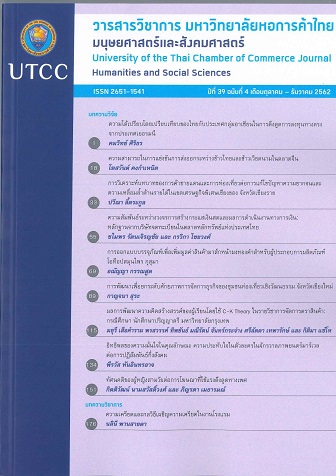The Influence of Attributional Confidence and Attraction in a Character Coming from Marvel Cinematic Universe on Parasocial Interaction
Main Article Content
Abstract
This research aimed to analyze correlation and predictor variables in the parasocial interaction process between an audience and a character from Marvel Cinematic Universe. The research method is the cross-sectional study, and the respondents were 456 Thais who were more 18 years old. Data gathered from the research was analyzed by employing exploratory factor analysis. The research result indicated that interpersonal attraction in this research comprised of 3 kinds: “shiftless attraction”, “trustworthiness attraction”, and “hard-to-reach attraction”. According to the hypothesis testing, Shiftless attraction and trustworthiness attraction correlated positively with, and were also predictor variables having an influence on, attributional confidence in a character. Trustworthiness attraction and hard-to-reach attraction correlated positively with, and were also predictor variables having an influence on parasocial interaction. Attributional confidence in a character correlated positively with, and were also predictor variables having an influence on parasocial interaction. This research result is able to be adapted in designing a character’s attribution on films and series to make audience feel attractive and create parasocial interaction. It is also gain benefit for further research related to parasocial interaction and parasocial relationship.
Article Details
ลิขสิทธิ์ของบทความ
ผลงานที่ได้รับการตีพิมพ์ถือเป็นลิขสิทธิ์ของมหาวิทยาลัยหอการค้าไทย ห้ามมิให้นำเนื้อหา ทัศนะ หรือข้อคิดเห็นใด ๆ ของผลงานไปทำซ้ำ ดัดแปลง หรือเผยแพร่ ไม่ว่าทั้งหมดหรือบางส่วนโดยไม่ได้รับอนุญาตเป็นลายลักษณ์อักษรจากมหาวิทยาลัยหอการค้าไทยก่อน
References
Berger, C. R., & Calabrese, R. J. (1975). Some explorations in initial interaction and beyond: Toward a developmental theory of interpersonal communication. Human Communication Research, 1, 99- 112.
Burke, L. (2018). A bigger universe: Marvel studios and transmedia storytelling. In J. C. Chambliss, W. L Svitavsky, & D. Fandino (Eds.). Assembling the Marvel Cinematic Universe: Essays on the social, cultural and geopolitical domains (pp. 32-51). Jefferson, NC: McFarland & Company.
Chambliss, J. C., Svitavsky, W. L., & Fandino, D. (2018). Introduction. In J. C. Chambliss, W. L. Svitavsky, & D. Fandino (Eds.). Assembling the Marvel Cinematic Universe: Essays on the social, cultural and geopolitical domains (pp. 1-8). Jefferson, NC: McFarland & Company.
Clatterbuck, G. W. (1979). Attributional confidence and uncertainty in initial interaction. Human Communication Research, 5(2), 147-157.
Cohen, J. (2009). Mediated relationships and media effects: Parasocial interaction and indentification. In R. L. Nabi & M. B. Oliver (Eds.). The SAGE handbook of media processes and effects (pp. 223-236). Los Angeles, CA: SAGE Publications.
Cohen, J. (1999). Favorite characters of teenage viewers of Israeli serials. Journal of Broadcasting and Electronic Media, 43, 327-345.
Cole, T., & Leets, L. (1999). Attachment styles and intimate television viewing: Insecurely forming relationships in a parasocial way. Journal of Social and Personal Relationships, 16(4), 495-511.
Giles, D. C. (2009). Parasocial interaction: A review of the literature and a model for future research. Media Psychology, 4, 279-305.
Horton, D., & Wohl, R. R. (1956). Mass communication and para-social interaction: Observations on intimacy at a distance. Interpersonal and Biological Processes, 19(3), 215-229.
McCroskey, J.C., & McCain, T.A. (1974). The measurement of interpersonal attraction. Speech Monographs, 41(3), 261-266.
Perse, E., & Rubin, R. B. (1989). Attribution in social and parasocial relationship. Communication Research, 16(1), 59-77.
Ramasubramanian, S., & Kornfield, S. (2012). Japanese anime heroines as role models for U.S. youth: Wishful identification, parasocial interaction, and intercultural entertainment effects. Journal of International and Intercultural Communication, 5(3), 189-207.
Rubin, A. M., Perse, E. M., & Powell, R. A. (1985). Loneliness, parasocial interaction, and local television news viewing. Human Communication Research, 12(2), 155-180.
Rubin, A. M., & Step, M. M. (2000). Impact of motivation, attraction, and parasocial interaction on talk radio listening. Journal of Broadcasting & Electronic Media, 44(4), 635-654.
Rubin, R. B., & McHugh, M. P. (1987). Development of parasocial interaction relationships. Journal of Broadcasting & Electronic Media, 31(3), 279-292.
Schramm, H., & Hartmann, T. (2008). The PSI-process scales: A new measure to assess the Intensity and breadth of parasocial processes. Communications, 33, 385-401.
Sood, S., & Rogers E. M. (2000). Dimensions of parasocial interaction by letter-writers to a popular entertainment-education soap opera in India. Journal of Broadcasting & Electronic Media, 44(3), 386-414.
Stever, G. S. (2010). Fan behavior and lifespan development theory: Explaining para-social and social attachment to celebrity. Journal of Adult Development, 18(1), 1-7.
Stever, G. S., & Lawson, K. (2013). Twitter as a way for celebrities to communicate with fans: Implications for the study of parasocial interaction. North American Journal of Psychology, 15(2), 339-354.


